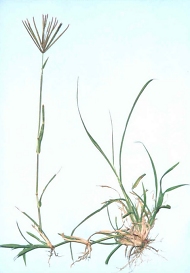| Name: | Rhodes grass (Chloris gayana) |
|---|
| Description: | Perennial. Most growth in spring, summer and autumn. Suited to a wide range of soils from light textured sandy loams to heavy textured soils. Moderate resistance to drought. Low resistance to frost. Spreads readily by runners. Useful for erosion control because of strong runner (stolon) growth and a vigorous root system. Useful also in controlling spiny burr grass. Easier to establish than many other tropical grasses although the fluffy seed is difficult to sow with conventional machinery. Suitable companion legumes for inland sowings are: lucerne, barrel medics, serradella, subterranean clover, and woolly pod vetch. Suitable companion legumes for coastal sowing are: white clover, Kenya clover, atro and lotus. Sow in spring, or late summer to early autumn. |
|---|
| Sowing rate: | 1–4 kg/ha. |
|---|
Minimum average
annual rainfall | (summer dominant) 500 mm. |
|---|
| Select varieties on the basis of: | - Maturity: Earlier maturity types are better suited to marginal growth areas and /or soil types that have poor moisture holding characteristics. The later the maturity, the more suited they are to higher rainfall areas and possible higher input management (e.g. nitrogenous fertiliser, irrigation and intensive grazing management).
- Local production and persistence trial information – inquire through your agronomist or adviser.
- The only tetraploid variety (Callide) has larger leaves, and responds well to increased fertility and irrigation, maintaining feed quality if well managed.
|
|---|
| Varieties: | Note: 'P' denotes that this variety is protected by Plant Breeder's Rights.| Varieties/brand | Main Seed Source |
|---|
| Early flowering diploids | | Pioneer | Public variety | | Late flowering diploids | | Katambora | Public variety | | Topcut | Selected Seeds P | | Finecut | Selected Seeds P | | Nemkat | Seedmark/PlantTech P | | Very late flowering tetraploid | | Callide | Public variety |
|
|---|



